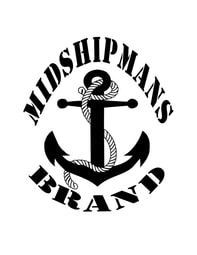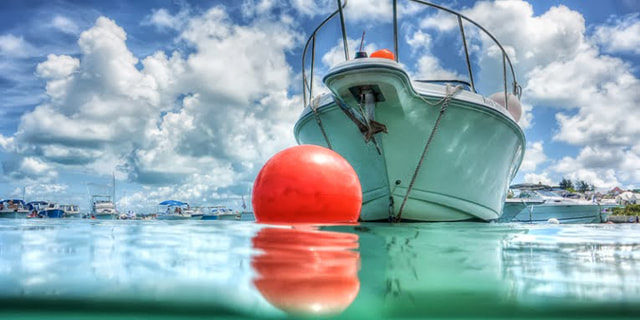Mooring Pendant... A secure line that attaches a vessel to a mooring buoy
(Pendant is pronounced "pennant" by sailors)
Northern sailors count on Midshipman's Brand mooring pendants to keep their vessels secure even in the worst Canadian winter storms.
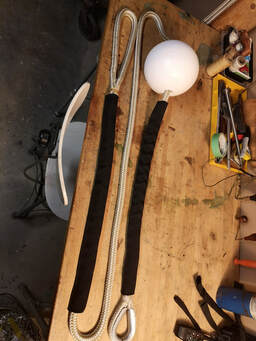
"Hold Fast Mooring Pendant"
HOLD FAST is a nautical term that means to bear down and fight through the storm. Throughout history, sailors have tattooed these 8 letters onto their knuckles to remind them that they can get through any storm as long as they "hold fast".
Our experienced riggers hand build our "Hold Fast" pendants from Samson double braid nylon line... one at a time.
How long should my pendant be? Tradition suggests that your pendant be two and a half times the freeboard height of your vessel. "Freeboard" is measured from the water line to the top of your gunwales (or deck). So for a vessel with a three foot freeboard, your pendant should be at least seven and a half feet long. Remember that this is just a rule of thumb. The actual length of your pendant may be longer or shorter depending on mooring conditions or harbour regulations.
To get the correct diameter line for your boat, 1/2 inch Samson double braid nylon line is recommended for up to a 25 foot vessel and 5/8th inch diameter for up to 35 feet.
What to look for in a mooring pendant
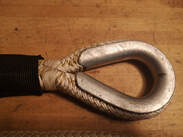
The end of the pendant that attaches to the mooring buoy has a hard eye with a heavy galvanized thimble spliced in before a Yale whipping is used to lock stitch the connection. This is a very strong splice that maintains almost all of the line's strength. The hard eye should be attached to the mooring buoy with a shackle (or preferably a swivel). Use correctly sized hardware. So for a half inch line, use at least a half inch shackle. Make sure that you "mouse" the shackle bolt after securing it with a wrench. Mousing is where you secure the shackle bolt with either Monel or galvanized wire.
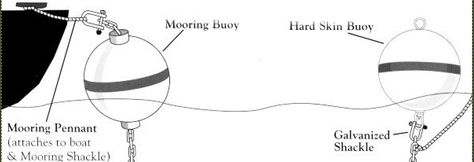
Buoys that have the riding chain run through the hollow centre and are secured with a shackle on the top of the buoy require that the pendant be attached to the top shackle.
Solid buoys with the riding chain shackled to the bottom of the buoy have the mooring pendant shackled to the top link of the riding chain underneath the buoy.
Solid buoys with the riding chain shackled to the bottom of the buoy have the mooring pendant shackled to the top link of the riding chain underneath the buoy.
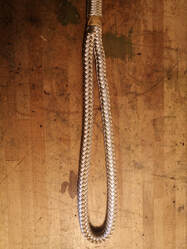
The end of the pendant that connects to the vessel is traditionally a soft loop that is also Yale whipped and lock stitched. The loop is rove through the cleat eye with the bight turned over the cleat's horns then pulled tight. Although this is simple, fast and secure, it can be more difficult to let go when under tension.
Many sailors prefer the vessel end of the pendant to have a simple whipping and the rope end melted. This gives you the most options for tying off to your boat. Just make sure that you know the correct way to attach a line to a cleat... it's easy to learn.
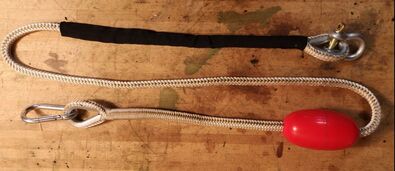
The other option is a hard eye with a metal thimble spliced in (just like the end attached to the buoy). This can be hooked or shackled to the vessel's tow eye, which being attached through the keel, is usually the most secure hardware on a vessel. This style can be a little more difficult to connect but is arguably the most secure... and doesn't have the same chafing issues as the other types of attachments as the pendant doesn't run over the deck or gunwale.
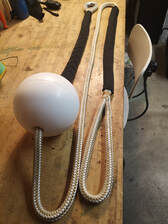
Although not absolutely necessary, a line float is a nice addition. It makes it so much easier to grab the mooring line with your boat hook. Keep in mind that nylon pendant line isn't buoyant, so without the float, the line would sink under the mooring buoy.
Chafing sleeves are important as well. Made of a nylon material, these sleeves fit loosely over the pendant line providing chafe protection from where the line rubs - or comes into contact with the vessel's deck or the bottom of the mooring buoy (in sea water, barnacles can attach to the underwater portion of the mooring buoy which could eventually damage the pendant.)
For next level protection... Midshipman's Brand "Storm Pendant"

For a "belt and suspenders" approach to mooring your boat, consider having a "storm pendant" available. Crafted from a product called Dyneema, this 3/8th inch line is stronger than steel and when properly spliced, retains practically all of it's 15,500 pound (7000kg) tensile strength. As there is basically no stretch, this pendant is not usually used as the everyday mooring line but is attached before an impending storm, or if you are leaving your vessel unattended at it's mooring for any length of time. The storm pendant should be slightly longer than your "Hold Fast Mooring Pendant" and attached along side it (in addition to it), but to different hardware on your boat. The idea is that although your standard Hold Fast Pendant is considered the ideal mooring line due to the strength and stretch properties of the nylon double braid and the construction of the splices, if it was to fail during an extreme weather event, the storm pendant would continue to hold. Midshipman's Brand makes the "Storm Pendant" with the same attention to detail and level of craftsmanship as it puts into the Hold Fast Pendants.
We proudly carry Midshipman's Brand, Hold Fast Mooring Pendants and Storm Pendants . We offer free delivery in Canada and the continental United States.
You can expect prompt delivery and what many mariners consider one of the toughest mooring pendants available anywhere. Prices start at $195 Canadian.
For more information or to place an order please contact Bart Bjorkman at 1-250-254-5076 or order online at [email protected]
You can expect prompt delivery and what many mariners consider one of the toughest mooring pendants available anywhere. Prices start at $195 Canadian.
For more information or to place an order please contact Bart Bjorkman at 1-250-254-5076 or order online at [email protected]
